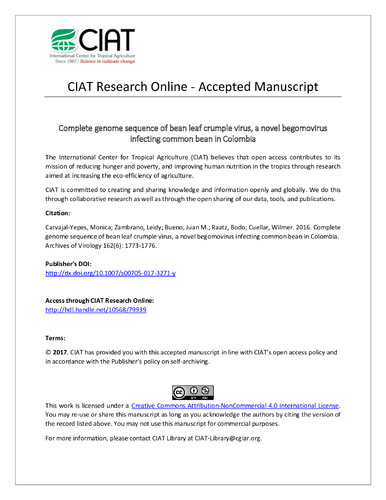Complete genome sequence of bean leaf crumple virus, a novel begomovirus infecting common bean in Colombia
A copy of the complete genome of a novel bipartite begomovirus infecting common bean (Phaseolus vulgaris L.) in Colombia was obtained by rolling-circle amplification (RCA), cloned, and sequenced. The virus is associated with leaf crumple symptoms and significant yield losses in Andean and Mesoamerican beans. Such symptoms have been reported increasingly in Colombia since at least 2002, and we detected the virus in leaf material collected since 2008. Sequence analysis showed that the virus is a member of a distinct species, sharing 81% and 76% nucleotide (nt) sequence identity (in DNA-A and DNA-B, respectively) to other begomoviruses infecting common bean in the Americas. The data obtained support the taxonomic status of this virus (putatively named ’bean leaf crumple virus’, BLCrV) as a member of a novel species in the genus Begomovirus.
Begomoviruses (family Geminiviridae) are emergent pathogens of crops whose dissemination has been favoured by the increasing populations of their whitefly vectors [1]. In the Americas, a series of whitefly-transmitted begomoviruses have been reported to affect bean crops, and most have been associated to leaf mosaic symptoms and important yield reductions [1, 2]. In Colombia, distinct symptoms of leaf crumpling have been reported in fields of dry and snap bean varieties since 2002 [3]. Since then, there has been a drastic decrease (60-70%) in the cultivated area in localities where the symptoms have been reported [3, 4]. The most recent outbreak was recorded during December 2015 in Rozo, Department of ‘Valle del Cauca’ (Colombia), with a prevalence of 40% in fields of ‘Blue Lake’ beans, a popular but extremely susceptible commercial variety (Fig. 1A). The putative begomovirus causing the disease was originally named “virus del arrugamiento foliar” (Spanish for ‘leaf crumple virus’) [3], but the complete sequence was not available until now.

